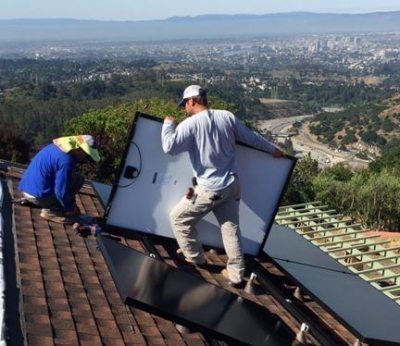The Ten Bagger In Solar Energy
What we are seeing now is nothing less than the complete remaking of the American energy supply.
It is a metamorphosis, just as, if not more, dramatic than the initial electrification of the United States launched by Thomas Edison in 1876.
Think of it as a disruptive technology with a turbocharger.
Eventually, the cost of energy will drop to near zero in today’s terms, possibly as soon as 2035. The consequences for your trading and investment portfolio will be tectonic.
This is what people don’t get about solar.
Traditional forms of energy production and consumption, such as for oil, coal, natural gas, and hydroelectric, are subject to only linear improvements. Solar ones benefit from exponential growth.
There is, in effect, a solar Moore’s Law that sees efficiencies per dollar spent doubling every four years, such as we have already seen with the faster growth of microprocessor efficiencies since the 1960’s. Exponential growth of efficiencies will bring exponential growth of profits.
I am old enough to have lived through several solar booms in the past, only to see them crash and burn.
In 1979, President Jimmy Carter installed panels on the White House roof to provide leadership during the Iran oil crisis, only to see them torn down by President Ronald Reagan three years later.
Solar is now growing far faster than any other power source in the US, some 50% a year for the past six years.
Annual installations of photovoltaic panels have soared from a token 0.3 gigawatts in 2000 to an impressive 7.286 gigawatts in 2015, more than enough to fuel 8.5 million American homes.
California alone now has 500,000 homes running on solar, about 4% of the total. Installation trucks from a myriad of different local companies are seen everywhere.
This is all happening because of the simultaneous maturing and cross-pollination of technology, regulation, financing, and venture capital.
A key development was Chinese entry into mass production of solar panels, which led to a near immediate 80% collapse in prices. They now control 70% of the global market.
But this also led to the bankruptcy of a large number of US producers, including the ill-fated Solyndra, which I drive by every time I visit Tesla.
Chinese exports of panels to the US are now subject to anti dumping duties. This was all a windfall for the installation business.
Also helping has been the 90% collapse in the price of polysilicon, a key manufacturing component. Silicone (Si) is, in fact, one of the most common elements on the planet.
Still, the soft costs of sales, design, permitting, and labor, account for two thirds of a new installation today. By the way, solar has also proven a prolific new job creator. I can assure you, the cost of labor is never going to zero.
Some 15 years ago, I tried to install solar on my home and sell peak power to the grid. PG&E told me this was “illegal” because I would crash the grid, something I knew was patently false.
This time around, my city permits sailed through effortlessly, and I received a polite email from PG&E instructing me how to read my new “net metering bill”. I wish renewing my driver’s license was so easy (that damn vision test).
For the first time in history, solar power is now cheaper than grid power on a non-subsidized basis. Costs are set to still fall dramatically from here. Fossil fuels are about to become, well, fossils.
The Paris based International Energy Agency, no slouch when it comes to analyzing power data, predicts that solar will account for 27% of the global power supply by 2050, and will become the biggest single source.
But futurologist friends of mine, like Tesla’s (TSLA) Elon Musk, Google’s head of engineering, Ray Kurzweil, and cosmologist Dr. Stephen Hawking, believe there is no reason why it shouldn’t be at 100% by 2030-35. To quote Kurzweil, “we are only six more doublings away.”
Google (GOOG), by the way, is already one of the world’s largest generators and distributors of solar power, while Musk is the preeminent installer through his participation in Solar City (SCTY).
Governments have been pouring fuel on the solar fire. Germany took an early lead, installing a massive 35 gigawatts over the past decade. It has since decided to shutter its entire nuclear industry, and offset its production with alternatives. But many of its subsidy programs were deep sixed by the crash.
President Obama made a 30% investment tax credit a central plank of his 2009 supplementary budget, which led to the current American solar renaissance.
That incentive expires in 2021, after getting a five year extension in a rare bipartisan deal in congress.
President Obama also upped the ante by using the Environmental Protection Agency to force power utilities to cut carbon emissions by 32% from 2005 levels. That involves setting a target of 28% alternative energy power generation by 2030.
The whole idea of using natural gas as a low carbon stepping stone has been abandoned.
Hillary Clinton has recently weighed in with her own plans to shift the country from a carbon to a solar energy based economy, if elected president.
She wants nothing less than to eliminate all oil and gas subsidies worth $100’s of billions, and shift the money to alternatives.
That is a radical move. Her goal is to increase the solar share of American power generation to 33% by 2027.
Individual states have weighed in with their own measures. California has mandated that its residents obtain 30% of their power from alternatives by 2020.
More than two dozen other states have followed with similar measures, including several red ones. Solar is starting to transcend the political spectrum; the numbers are so compelling.
This isn’t just a US phenomenon, but a global one. Saudi Arabia has two of the world’s largest solar plants on the drawing board, to produce some 2 megawatts.
After all, why burn $5 oil when you can sell it to foreigners (mostly the Chinese) at an extravagant $50 a barrel. They are also major investors in the San Francisco alternative energy scene.
China is building far and away the biggest solar infrastructure, and wants to build 70 gigawatts over the next two years.
Japan has a 20% solar target, thanks to the Fukushima nuclear disaster. India plans to provide cheap electricity via solar to 100,000 villages for the first time.
Improving solar cell efficiencies promises to take us further and faster into this brave new world.
My own SunPower (SPWR) X-335 panels, with their patented Maxeon solar cells, convert 20.3% of the sunlight they receive into electricity, the highest in the industry. Cheap imported Chinese panels offer efficiencies as low as 16% and don't last nearly as long.
University labs have perfected cells with 45% efficiencies using advanced silicon compounds. I happen to know that the military has a 65% efficient cell. All that remains are the economies of mass production to bring them to the public market.
This is crucial for the solarization of the global economy. Every 1% improvement in efficiencies cuts that total cost of a new installed system by 5%.
With the trends already in place, it is safe to assume that solar energy costs will fall by at least 10% a year for the foreseeable future. First Solar (FSLR), which specializes in large scale, thin film, industrial facilities, expects solar costs to plunge from 63 cents per kilowatt in 2014 to only 40 cents by 2017.
Storage is another key part of the equation, as panels alone can only produce electricity during daylight. The cost of home storage batteries, which are charged by day and can run a home at night, have dropped by 70% over the past five years.
They could drop another 70%, once Solar City completes its Nevada Gigafactory in 2017. That will double the planet’s lithium ion battery capacity in one shot. A second plant is planned.
What are the investment implications of all this? Clearly all of the companies mentioned in this piece are about to see their market size increase 30 fold.
But, what about everyone else?
The elimination of energy as a cost has enormous consequences for all companies. You can start with the energy intensive ones in transportation, steel, and aluminum, and work your way down the list.
The profitability and efficiency of the entire economy will take a great leap forward, much like we saw with the mass industrialization that was first made possible by electricity during the 1920’s. Share prices of all kinds will go ballistic.
Dow 200,000 anyone?
Since energy costs will eventually fall effectively to zero, that wipes out the present business model of the entire electric power industry. It will be the same as trying to sell something that is free, like air.
That will force them to morph from energy producers to power distributors. Watch this space for a future piece on this issue.
So when readers ask me for the names of shares of companies that have the potential to rise tenfold in ten years, this is one industry I always steer them towards.





Joining the Brave, New World
The Diary of a Mad Hedge Fund Trader, published since 2008, ...
more




I'm sure there will be advancements in solar energy and other forms of renewable energy but I doubt that energy will be such a low cost commodity that it will not be important. I remember in the early 60's when nuclear energy was all the range, the talk then was that electricity would be so cheap they would not even meter it. We we all know how that turned out. One thing that you are forgetting is that everything has a maintenance cost and replenishment cycle. I don't think you have factored in those cost. As for an investment thesis both the installation and maintenance of solar need to be considered.